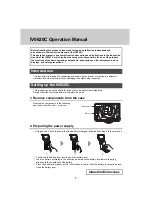
4-15
IM 704420-01E
Setting Measurement Conditions
4
4.8
Adjusting the Phase Difference between the
Data Signal and the Clock Signal (Applicable to
D-to-C Jitter Measurements)
«For a functional description, see section 1.4.»
Keys
KEY
LOCK
MEAS
SET
AVE
/T
0
2
4
4
8
6
12
8
16
10
%
deg
%
20
180
us
ms
ns
MEAS
x1
3TCD
xN
3TCD
xN
BI-PHASE
SPEED
DELAY
GATE TIME
FUNC
GATE
LOCAL
DATA
SCALE
PRESET
PHASE
10
20
TRIG
CLOCK
PHASE
AUTO MAN
GP-IB
REMOTE
EQLZ
LEVEL
PLL
SHIFT
ARM
INH
DtoC
DVD
0.1s
0.5s
MAN
UTILITY
OPTION
10
5
σ
σ
When adjusting the phase of the clock signal,
the adjusted value is displayed.
Lights when the numeric values are shown on the display.
Procedure
When the measurement function is set to [DtoC DVD] (D-to-C jitter), you can adjust the
phase difference of the clock signal.
1.
Press the PHASE key. The PHASE indicator blinks, and the 10% and 20%
indicators of the SCALE key light. The phase difference (deg) between the data
signal and the clock signal is indicated on the analog meter.
2.
Use the rotary knob and arrow keys (< or >) to set the phase adjustment value.
The meter needle changes according to the changes in the adjustment value.
For the procedure to set numeric values, see section 3.7.
Explanation
Adjusting the phase difference
When using the clock signal that is applied to the clock input connector to make D-to-
C jitter measurements, you can change the amount of delay of the clock signal using
the internal circuit and adjust the phase difference between the data signal and the
clock signal. This cannot be applied to the clock signal that is regenerated by the PLL
circuit.
• Range: 0.0 ns to 40.0 ns
• Resolution: 0.1 ns
Meter indication of the phase difference
The phase difference between the data signal and the clock signal can be indicated
on the analog meter in the range from 0 deg to 360 deg. The scale line is written
every 90 degrees. If you adjust the phase difference so that it is 180 (deg), the
measured values of the D-to-C is distributed around T/2 (T is the period of the clock
signal) resulting in a more accurate D-to-C jitter measurement.
Note
When the measurement function is set to [DtoC DVD] (D-to-C jitter) and the PLL circuit is
turned OFF, you can adjust the phase difference of the clock signal.
















































